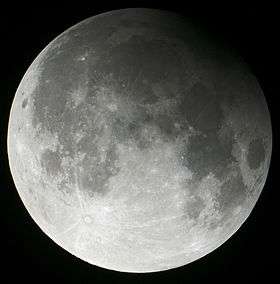Gamma (eclipse)

Gamma (denoted as γ) of an eclipse describes how centrally the shadow of the Moon or Earth strikes the other. The distance, when the axis of the shadow cone passes closest to Earth or Moon's center, is stated as a fraction of the equatorial radius of the Earth. The sign of gamma defines, for a solar eclipse, if the axis of the shadow passes north or south of the center of the Earth; a positive value means north. For a lunar eclipse it defines whether the axis of the Earth's shadow passes north or south of the Moon; a positive value means south. For solar eclipses the Earth is defined as that half which is exposed to the Sun (this changes with the seasons and is not related directly to the Earth's poles or equator, thus the Earth's center is wherever the Sun is directly overhead).
The adjoining diagram illustrates solar eclipse gamma: The red line shows the least distance from the center of the Earth, in this case approximately 75% of radius of the Earth. Because the umbra passes north of the Earth's center, gamma in this example is +0.75.
The absolute value of gamma allows us to distinguish different kinds of solar eclipses:[1]
- If gamma is 0 the axis of the shadow cone is exactly between the northern and southern halves of the sunlit side of the Earth (for solar eclipses) or Moon (for lunar eclipses) when it passes over the center.
- If gamma is lower than 0.9972, the eclipse is central. The axis of the shadow cone strikes the Earth and there are locations on Earth, where the Moon can be seen central in front of the Sun. Central eclipses can be total or annular (if the tip of the umbra reaches surface of Earth barely reaches earth the type can change during the eclipse from annular to total and vice versa, this is called a hybrid eclipse).
- If gamma constitutes between 0.9972 and 1.0260 the axis of the shadow cone misses Earth, but because of the umbra or antumbra has a certain width in some circumstances a part of the umbra or antumbra can touch Earth in polar regions. The result is a non central total or annular eclipse.
- If gamma is between 0.9972 and approximately 1.55 and the special circumstances mentioned above do not occur the eclipse is partial, the Earth traverses only the penumbra.[2]
If the Earth were a sphere, the limit for a central eclipse would be 1.0, but because of the oblateness of the Earth it is 0.9972.[3]
The Solar eclipse of April 29, 2014 with gamma of 1.0001 constitutes the special case of an annular but not central eclipse. The axis of the shadow cone barely misses Earth's south. Thus no central line can be specified for the zone of annular visibility.[4]
References
- ↑ J. Meeus: Astronomical Algorithms. 2nd ed., Willmann-Bell, Richmond 2000, ISBN 0-943396-61-1, Chapter 54
- ↑ The radius of penumbra of the Moon in the fundamental pane is about 0.53 to 0.57 of the Earth's radius.
J. Meeus: Mathematical Astronomy, Morsels, Willmann-Bell, 2000, ISBN 0-943396-51-4, Fig. 10.c. und
J. Meeus: Mathematical Astronomy, Morsels III, Willmann-Bell, 2004, ISBN 0-943396-81-6, Page 46 - ↑ J. Meeus: Mathematical Astronomy Morsels III. Willmann-Bell, Richmond 2004, ISBN 0-943396-81-6, Chapter 6
- ↑ Fred Espenak: Path of the Annular Solar Eclipse of 2014 Apr 29

